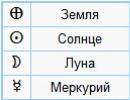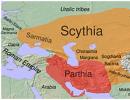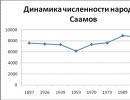State autonomous educational institution of higher education. What does an autonomous educational institution mean?
University centers of the country for training international specialists. The date of creation of the university is considered to be October 14, 1944, when the Council of People's Commissars transformed the International Faculty of M.V. Lomonosov Moscow State University, created a year earlier, into an independent institute. The first intake at MGIMO was 200 students. Since 1946, students from foreign countries began to be sent to study at MGIMO. In the early years, the university had three faculties: international, economics and law. In 1954, an eastern branch was opened at MGIMO. This happened as a result of a merger with one of the oldest Russian universities - the Moscow Institute of Oriental Studies, the successor of the Lazarevsky School, created in 1815. The famous Lazarevsky Library, which had no equal in the composition of Orientalist literature in Moscow, also went to MGIMO. In 1958, the Institute of Foreign Trade of the Ministry of Foreign Affairs of the USSR, created in 1934 in Leningrad and then transferred to Moscow, merged into MGIMO.
The Moscow State Institute of International Relations (University) of the Ministry of Foreign Affairs of the Russian Federation is a federal state autonomous educational institution of higher education, implements educational programs of higher and additional professional education and carries out fundamental and applied scientific research.
MGIMO is the legal successor of the Moscow State Institute of International Relations of the Ministry of Foreign Affairs (MFA) of the USSR, created in 1944 under the NKID (then the Ministry of Foreign Affairs) of the USSR, and transferred to the jurisdiction of the Ministry of Foreign Affairs of Russia in accordance with the Decree of the President of the Russian Federation of December 18, 1991 No. 291 “On foreign policy service of the RSFSR".
Full name of MGIMO: Federal State Autonomous Educational Institution of Higher Education "Moscow State Institute of International Relations (University) of the Ministry of Foreign Affairs of the Russian Federation."
Short name: MGIMO Ministry of Foreign Affairs of Russia.
Address: 119454 Moscow, Vernadsky Avenue, 76.
Branches: yes.
Mode, work schedule: Mon-Sat: 8:00–22:00
Information about the founders
The founder of MGIMO is the Russian Federation.
The functions and powers of the founder of MGIMO are carried out by the Ministry of Foreign Affairs of the Russian Federation.
Full name of the head of the founder: Lavrov Sergey Viktorovich, Minister of Foreign Affairs.
Founder address: 119200 Moscow, Smolenskaya-Sennaya pl., 32/34
Phone: +7 499 244-24-69
Email: [email protected]
Website: mid.ru
Branches
Odintsovo branch of the federal state autonomous educational institution of higher education "Moscow State Institute of International Relations (University) of the Ministry of Foreign Affairs of the Russian Federation."
Short name: Odintsovo branch of MGIMO University of the Russian Foreign Ministry.
1. An autonomous institution is recognized as a non-profit organization created by the Russian Federation, a constituent entity of the Russian Federation or a municipal entity to perform work, provide services in order to exercise the powers of state authorities, the powers of local government bodies provided for by the legislation of the Russian Federation in the fields of science, education, healthcare, culture, media, social protection, employment, physical culture and sports, as well as in other areas in cases established by federal laws (including when carrying out activities to work with children and youth in these areas).
2. An autonomous institution is a legal entity and, on its own behalf, can acquire and exercise property and personal non-property rights, bear responsibilities, and be a plaintiff and defendant in court.
3. An autonomous institution created on the basis of property in federal ownership, an autonomous institution created on the basis of property owned by a constituent entity of the Russian Federation, an autonomous institution created on the basis of property in municipal ownership, has the right to open accounts in credit institutions and (or) personal accounts, respectively, in the territorial bodies of the Federal Treasury, financial bodies of the constituent entities of the Russian Federation, municipalities.
(see text in the previous edition)
3.1. The founders of autonomous institutions created on the basis of property owned by a constituent entity of the Russian Federation (municipal property) have the right to enter into agreements on opening personal accounts with territorial bodies of the Federal Treasury for autonomous institutions under their jurisdiction.
3.2. The opening and maintenance of personal accounts for autonomous institutions in the territorial bodies of the Federal Treasury is carried out in the manner established by the Federal Treasury.
(see text in the previous edition)
3.3. The opening and maintenance of personal accounts for autonomous institutions with the financial authority of a constituent entity of the Russian Federation (municipal entity) is carried out in the manner established by the financial authority of the constituent entity of the Russian Federation (municipal entity).
3.4. Carrying out cash transactions with funds of autonomous institutions for which personal accounts have been opened in accordance with parts 3.2 and 3.3 of this article is carried out on behalf of and on behalf of these institutions by territorial bodies of the Federal Treasury, financial authorities of the constituent entities of the Russian Federation, municipalities in the manner established respectively by the Federal Treasury , the financial authority of a constituent entity of the Russian Federation, a municipal entity, within the limits of the balance of funds reflected in the corresponding personal account.
(see text in the previous edition)
3.5. Accounts opened by territorial bodies of the Federal Treasury, financial bodies of constituent entities of the Russian Federation, municipalities to record transactions with funds received by autonomous institutions are serviced by institutions of the Central Bank of the Russian Federation and credit organizations without charging a fee.
3.6. Transactions with funds received by autonomous institutions from the corresponding budget of the budget system of the Russian Federation in accordance with Article 78.2 of the Budget Code of the Russian Federation in the manner established respectively by the Government of the Russian Federation, the highest executive body of state power of a constituent entity of the Russian Federation, the local administration of a municipality, are taken into account on individual accounts accounts of autonomous institutions opened by them in the territorial bodies of the Federal Treasury, financial bodies of the constituent entities of the Russian Federation, municipalities.
(see text in the previous edition)
3.7. Transactions with funds received by autonomous institutions from the relevant budget of the budget system of the Russian Federation in accordance with the Budget Code of the Russian Federation are accounted for in the accounts opened by them in accordance with Part 3 of this article in credit institutions after checking the documents confirming the cash expenses made, in the manner established the relevant financial authority in accordance with Part 3.10 of this article, or on separate personal accounts of autonomous institutions opened by it in the territorial bodies of the Federal Treasury, financial authorities of the constituent entities of the Russian Federation, municipalities. Funds recorded in separate personal accounts of autonomous institutions opened by them in territorial bodies of the Federal Treasury, financial authorities of constituent entities of the Russian Federation, municipalities can be used to reimburse cash expenses incurred by institutions from accounts opened by them in credit institutions or from personal accounts autonomous institutions opened by him in the territorial bodies of the Federal Treasury, financial authorities of the constituent entities of the Russian Federation, municipalities to account for transactions with funds received by autonomous institutions from income-generating activities, and with funds received by autonomous institutions from the corresponding budget of the budget system of the Russian Federation in accordance with Budget Code of the Russian Federation, after checking the documents confirming cash expenses subject to reimbursement, in the manner established by the relevant financial authority in accordance with part 3.10 of this article.
(see text in the previous edition)
3.8. Transactions with funds received by autonomous institutions within the framework of compulsory health insurance are recorded on separate personal accounts of autonomous institutions to account for transactions with funds of compulsory health insurance opened by them in the territorial bodies of the Federal Treasury, financial authorities of the constituent entities of the Russian Federation, and municipalities.
3.9. Expenses of autonomous institutions, the source of financial support of which are funds received by autonomous institutions in accordance with paragraph one of paragraph 1 of Article 78.1 of the Budget Code of the Russian Federation, as well as funds received by these institutions as part of compulsory medical insurance, recorded on the personal accounts of autonomous institutions opened by them in the territorial bodies of the Federal Treasury, financial bodies of the constituent entities of the Russian Federation, municipalities, are carried out without them submitting to the territorial bodies of the Federal Treasury, financial bodies of the constituent entities of the Russian Federation, municipalities documents confirming the occurrence of monetary obligations, unless otherwise established by federal laws, laws of the constituent entities of the Russian Federation Federation, municipal legal acts of representative bodies of municipalities, respectively.
(see text in the previous edition)
3.10. Expenses of autonomous institutions, the source of financial support of which are funds received by autonomous institutions in accordance with paragraph two of paragraph 1 of Article 78.1 of Article 78.2 of the Budget Code of the Russian Federation, are carried out after verification of documents confirming the occurrence of monetary obligations, compliance with the requirements established by part 3.11-1 of this article , and compliance of the content of these operations with the purposes of providing subsidies and budgetary investments in the manner established by the relevant financial authority for authorizing these expenses.
(see text in the previous edition)
(see text in the previous edition)
3.11-1. When concluding contracts (agreements) for the supply of goods, performance of work, provision of services involving advance payments, autonomous institutions comply with the requirements defined by regulatory legal acts of the Russian Federation, regulatory legal acts of the constituent entities of the Russian Federation, municipal legal acts regulating budgetary legal relations for recipients of funds the corresponding budget of the budget system of the Russian Federation.
3.12. Autonomous institutions exercise in the manner established by the Government of the Russian Federation, the highest executive body of state power of a constituent entity of the Russian Federation, the local administration of a municipality, the powers of the federal government body (state body), the executive body of state power of a constituent entity of the Russian Federation, a local government body, respectively, to execute public obligations to individuals to be fulfilled in cash.
3.13. Financial support for the exercise by autonomous institutions of the powers of a federal government body (state body), an executive body of state power of a constituent entity of the Russian Federation, a local government body to fulfill public obligations to individuals subject to execution in monetary form is carried out in the manner established accordingly by the Government of the Russian Federation, the highest executive body of state power of the constituent entity of the Russian Federation, the local administration of the municipality.
3.14. Operations with funds carried out by autonomous institutions in cases and in the manner established by regulatory legal acts of the Government of the Russian Federation, regulatory legal acts of the highest executive body of state power of a constituent entity of the Russian Federation, legal acts of the local administration of a municipality, on behalf of and on behalf of the federal government body, respectively government (state body), government body of a constituent entity of the Russian Federation, local government body, and operations for the fulfillment of public obligations to individuals subject to execution in cash are recorded on a personal account opened by the relevant government body (state body), local body self-government as a recipient of budget funds.
3.15. Unused balances of funds provided to an autonomous institution from the corresponding budget of the budget system of the Russian Federation in accordance with paragraph one of paragraph 1 of Article 78.1 of the Budget Code of the Russian Federation are used in the next financial year in accordance with the financial and economic activity plan of the autonomous institution to achieve the purposes for which this institution was created, when the autonomous institution achieves the indicators of the state (municipal) task for the provision of state (municipal) services (performance of work), characterizing the volume of state (municipal) service (work). Federal laws, laws of constituent entities of the Russian Federation, municipal legal acts of representative bodies of municipalities may provide for the return to the appropriate budget of the balance of the subsidy for the implementation of a state (municipal) task, respectively, by federal autonomous institutions, autonomous institutions of a constituent entity of the Russian Federation, municipal autonomous institutions in an amount corresponding to the achieved indicators of the state (municipal) assignment by the specified institutions.
(see text in the previous edition)
3.16. The balances of funds received by the autonomous institution within the framework of compulsory health insurance that are not used in the current financial year are used in the next financial year for the same purposes.
3.17. Unused balances of funds provided to an autonomous institution from the corresponding budget of the budget system of the Russian Federation in accordance with paragraph two of paragraph 1 of Article 78.1 in the current financial year (in the case of transactions with these funds on the personal accounts of autonomous institutions opened by them in the territorial bodies of the Federal Treasury, financial bodies of the constituent entities of the Russian Federation, municipalities) and Article 78.2 of the Budget Code of the Russian Federation, are subject to transfer by an autonomous institution to the corresponding budget of the budget system of the Russian Federation.
(see text in the previous edition)
3.18. The balances of funds provided for in Part 3.17 of this article, not used in the current financial year, may be used by autonomous institutions in the next financial year if there is a need to direct them for the same purposes in accordance with the decision of the relevant body exercising the functions and powers of the founder of the autonomous institution.
(see text in the previous edition)
3.19. Foreclosure of funds from autonomous institutions whose personal accounts are opened with territorial bodies of the Federal Treasury, financial bodies of constituent entities of the Russian Federation, municipalities, is carried out in a manner similar to the procedure established by Part 20 of Article 30 of the Federal Law of May 8, 2010 N 83-FZ " On amendments to certain legislative acts of the Russian Federation in connection with the improvement of the legal status of state (municipal) institutions" for budgetary institutions.
3.19-1. Establish that the balances of funds of federal autonomous institutions, autonomous institutions created by constituent entities of the Russian Federation, in the budgets of which the estimated share of interbudgetary transfers from the federal budget (except for subventions) during two of the last three reporting financial years did not exceed 20 percent of the volume of own revenues of the consolidated budget constituent entities of the Russian Federation, on the accounts of territorial bodies of the Federal Treasury, financial bodies of the specified constituent entities of the Russian Federation, opened in institutions of the Central Bank of the Russian Federation in accordance with the legislation of the Russian Federation, which reflect transactions with funds of these autonomous institutions, can be transferred from these accounts to the appropriate budget budget system of the Russian Federation with their return to the accounts from which they were previously transferred in accordance with this part, including for the purpose of executing settlement documents submitted by autonomous institutions specified in this part, to the territorial bodies of the Federal Treasury, financial bodies of the specified entities of the Russian Federation within the time limits provided for in Part 3.21 of this article, in the manner established respectively by the Ministry of Finance of the Russian Federation and the financial authorities of the specified constituent entities of the Russian Federation.
3.20. Establish that the balances of funds of autonomous institutions created by constituent entities of the Russian Federation, municipalities, with the exception of the balances of funds of autonomous institutions created by constituent entities of the Russian Federation and specified in part 3.19-1 of this article, on the accounts of territorial bodies of the Federal Treasury (opened in the cases provided for in part 3.1 of this article), financial bodies of the constituent entities of the Russian Federation, municipalities opened in institutions of the Central Bank of the Russian Federation in accordance with the legislation of the Russian Federation, which reflect transactions with funds of autonomous institutions, can be transferred from these accounts to the corresponding budget of the budget system of the Russian Federation with their return to the accounts from which they were previously transferred in accordance with this part, for the purpose of executing settlement documents submitted by the autonomous institutions specified in this part, to the territorial bodies of the Federal Treasury, financial bodies of the specified constituent entities of the Russian Federation, municipalities within the time limits, provided for
Federal State Autonomous Educational Institution
higher education
"NATIONAL RESEARCH UNIVERSITY "HIGH SCHOOL OF ECONOMICS""
On August 12, 2008, HSE came under the jurisdiction of the Government of the Russian Federation. Until August 12, 2008, HSE was under the jurisdiction of the Ministry of Economic Development and Trade of the Russian Federation.
In 1996, the Higher School of Economics opened its first regional campus in Nizhny Novgorod. The following year, the School's campuses opened in St. Petersburg and Perm.
By the decision of the competition commission of the Ministry of Education and Science of the Russian Federation dated October 7, 2009, the category “national research university” was established in relation to HSE.
By Decree of the Government of the Russian Federation dated February 1, 2016 No. 56, the official name of the Higher School of Economics was also changed (the word “professional” has been removed from the name). The full name is: Federal State Autonomous Educational Institution of Higher Education “National Research University “Higher School of Economics”.
By Decree of the Government of the Russian Federation of December 23, 2010 No. 1109 “On the creation of the federal state autonomous educational institution of higher professional education “National Research University “Higher School of Economics””, the university received the status of an autonomous educational institution. Until December 23, 2010, the university bore the official name SU-HSE.
On December 30, 2011, the Moscow State Institute of Electronics and Mathematics (MIEM) and two institutions of additional professional education - the Training Center for Management Training and the State Academy of Investment Sector Specialists (GASIS) - were affiliated with the Higher School of Economics.
Autonomous educational institutions are non-profit educational organizations created with the support of regional and federal authorities. For the most part, they are completely dependent on budget revenues (subsidies) and are created to solve specific problems.
The essence of the work
An autonomous institution is created with public funds, and also not the funds of individuals and legal entities to provide certain services to the population, both for money and for free.
The need to create such institutions in the country has been long overdue and this applies not only to the provision of educational services, but also to other areas of social services.
The essence of the work of an educational autonomous institution is to provide basic educational services, if required by the order of the state, which pays for them, for the student free of charge or at a minimal price.
The difference later the state subsidizes from the budget. The institution also has the right to conduct business, provide additional services or rent out equipment or premises.
Receive money for research and examination, sell patents for inventions. Educational institutions may receive income from such activities and distribute it at their own discretion, if this does not contradict Russian legislation.
The main difference from other types of organization
The main difference between autonomous educational institutions is that they can independently manage the funds received, no matter from what source they were received.
They have right to take out a bank loan and are liable for their obligations with the property they have. Accordingly, they may be declared bankrupt, but this rarely happens. At least, there have been no such precedents in Russian judicial practice since the adoption of the law in 2006.
Autonomous organizations are not completely independent institutions! And although they have significantly greater freedom of action compared to other species, they are also dependent on decisions and decrees made by regional and federal authorities and the Treasury, and are also obliged to comply with laws, rules and standards.
If a school has been re-registered as an autonomous organization, this does not mean that schooling will be paid. Training will be free, as it is provided for by the laws of the Russian Federation, but additional classes, which are not related to the school curriculum, but will be useful for the overall development of the student, may become paid.
For example, classes in judo sections or sewing clubs. By the way, if necessary, an autonomous educational institution can be transferred to a budgetary or municipal one, if it is more profitable, and the management of the organization will not even have to re-register documents.
The funds received from the provision of such educational services should be spent on improving the premises and local areas of the school, on the purchase of educational equipment and materials.
What exactly to spend the money on - decided by the school management. However, it cannot spend it on anything else or use the money for personal needs; all the money must go to the development of the institution. For violating the law, such an establishment may be closed or fined.
Otherwise, it is the same educational organization in which the same subjects are taught, as in other schools.
Myths and truth about the work of autonomous educational institutions
The lack of information about what an autonomous educational institution is has led to the emergence of many myths. So the most common misconception is that autonomous organizations are private institutions that work according to their own rules. Actually this is not true.
Most existing organizations created by the state and even those created by private individuals operate with state support, including financial support. The services provided by such an organization must comply with educational standards accepted in Russia.
Some autonomous educational institutions specialize exclusively on the provision of paid training services.
For example, teaching dance or stagecraft lessons. They conduct courses in working specialties - they provide an opportunity to become a seamstress, painter, electrician, etc. Although such institutions are most often private or created on the basis of private initiative, the state helps them by giving orders and subsidizing their activities.
Certificates issued by such institutions are accepted on a par with certificates issued by budgetary and municipal institutions.






